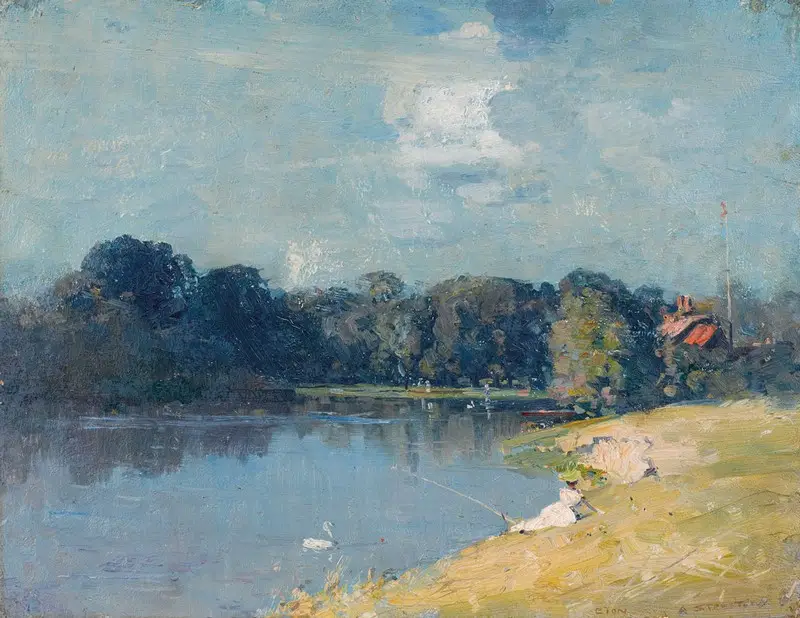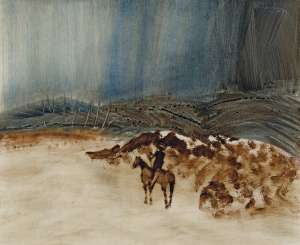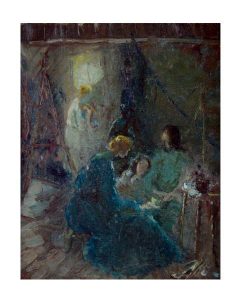The sale of Arthur Streeton painting The Windsor Damsel, Fishing earlier this year raised a few eyebrows in the art world. The rarity of Streeton works, the condition of the painting and the unquestionable esteem of the artist had contributed to its estimated market value of $40,000–$50,000. But the impact of the painting’s provenance had been greatly misjudged. Streeton’s oil on canvas had once hung in the home of legendary soprano Dame Nellie Melba, and when the hammer finally fell, the diva’s Damsel sold for around four times its estimated worth. Art valuation can seem like a nebulous craft to those unversed in the world of fine paintings and sculptures.
If the mere fact of prior ownership can cause a bidding frenzy at auction, how can an artwork’s true value be determined? This question is gaining a lot of attention from one group of investors.
THE NEW ART OF SMSF
Changes in Australian self-managed super fund (SMSF) regulations have taken much of the enjoyment out of art investment. People who hold art in their SMSF can no longer display it. Art purchased through SMSFs after 1 July 2011 must be separately insured and securely stored away from the home.
“It’s considered a personal use asset and, in the context of art, personal use is defined as looking at it,”
“It’s considered a personal use asset and, in the context of art, personal use is defined as looking at it,” explains John Kelly, Director of Self Super Insurance, which specialises in art investment.
The loss of enjoyment and the added cost of compliance have seen a drop in the value of art held in SMSFs. Australian Taxation Office (ATO) figures showed the value of art and collectables held in SMSFs in 2012 to be $731 million.
Two years later, that number had fallen to $589 million.
David Hulme, Director at Banziger Hulme Fine Art Consultants, explains that rather than a mass dumping of art from SMSFs, many investors have chosen to purchase their investment from their super funds so they can hang it in their home or office. “We’re creating a lot of valuations for people who are taking art out of their super funds,” he says.
FINDING VALUE
For those who choose to keep their art locked away in an SMSF, the potential return on investment is now its primary source of value. An artwork’s first sale through a gallery is considered its primary market; however, it is in the auction room – the secondary market – where a work’s true value is usually determined.
Gary Singer, CEO of Sotheby’s Australia, which auctioned the Melba collection this year, says valuation follows a simple formula. “It’s like when you value a block of land,” he says. “You value it on what people paid recently and in the past, and we add on the rarity factor.”
It sounds simple enough, but, like all investments, art is subject to changing market conditions, and the global financial crisis had a significant impact on auction sales. “Art sales [in Australia] in 2007 were about $175 million and they dropped very substantially, down to about $110 million,” says David, adding that the market for Indigenous Australian art is yet to recover. “Massive oversupply was a problem. Whereas most Australian artists normally have exhibitions of their work and put it on consignment with galleries, dealers would often purchase Indigenous art directly from the artists and then onsell it. Clearance rates are often down around 40 per cent, so it just doesn’t make it viable to sell. You need at least a 60 per cent clearance rate at auction to make it viable.”
Art is also vulnerable to the whims of fashion. The bicentenary of Australia was a boom time for colonial paintings, but increased urbanisation and the rise of modern apartment living have made abstract work more popular today.
“People don’t necessarily want paintings with lots of gum trees these days, unless they’re by the best-known exponents of them, like Albert Namatjira or Hans Heysen,” says David.
INSURANCE VALUE VERSUS MARKET VALUE
Art is valued for two purposes – insurance and the market. When valued for insurance, a figure is determined not on an artwork’s potential sale price but rather on its estimated replacement value.
Olivia Fuller, fine art specialist with Leonard Joel auction house, says the insurance valuation considers how an owner would be sufficiently covered if the artwork were permanently damaged or lost. “We look at an artist’s current market value and also take into account what it might sell for at its highest and usually make that the value,” she says.
“It can often be two or three times the market value.”
Previous auction records are the first indication of market value. An artwork’s current condition must also be assessed.
An oil painting is generally more robust than a watercolour and tends to command a higher price.
“For watercolours, the paper doesn’t last as long because of the Australian sun,” explains David. “I’m valuing a very substantial collection of works of a colonial artist at the moment and the paper has deteriorated. It’s very different now as we have the ability to conserve paper, but it still doesn’t have the same resilience factor as canvas.”
RARITY AND PROVENANCE
Rare artworks tend to have a higher value. An artist such as Pro Hart, for example, was considerably more prolific than a painter such as Sydney-born Herbert Badham. There are fewer than 100 auction records for Badham’s work and the scarcity makes it more desirable. Deutscher and Hackett auctioned one Badham painting, Snack Bar, in May 2015. The pre-sale estimate was $90,000 to $120,000.
It sold for a staggering $456,000. When institutions or serious art collectors acquire works, they can disappear from the market for decades. This adds to their sense of rarity. When The Window, the last piece in Grace Cossington Smith’s interiors compositions, came out of private ownership in November 2014, it was expected to fetch $350,000 but sold at a Sotheby’s Australia auction for $671,000, setting a new benchmark for the Australian artist’s work.
“We have a current sale from the estate of the late David Clarke, who co-founded the Macquarie Bank,” says Gary. “Among the items is a 1955 John Brack painting, which is incredibly rare, and the market will absolutely determine the price for that rarity.”
As was seen in the Melba collection, provenance is also an important factor in a painting’s worth. However, in some instances, previous ownership matters very little. An Elvis triptych, which sold at auction for US$81.9 million in New York in 2014, had been owned by a German casino. Its provenance was irrelevant to its sale price, because the triptych had been painted by Andy Warhol, whose works consistently sell at a premium.
An artwork’s provenance can also be dubious, as was the case with the National Gallery of Australia’s purchase of Dancing Shiva in 2008. The NGA bought the 11th century bronze statue from New York art dealer Subhash Kapoor for US$5 million. Kapoor was later charged with illegally exporting Indian antiquities, and last year the NGA was forced to return the statue to India.
“Provenance insurance is an extension of art insurance, but it’s extremely expensive and, really, the only way you can get cover is if the provenance assessed,” explains John Kelly. “If it’s good enough to get the cover, you probably don’t need the cover.”
INSURANCE FOR ART’S SAKE
John predicts that 2016 will be a busy time for the art industry. Australian investors who purchased art for their SMSF prior to 1 July 2011 were given a five-year grace period in which to comply with ATO regulations of separate storage and insurance for their art.
“They haven’t been allowed to display the art since July 2011, but they could store it in their home,” he explains.
“That will change next year and it will be a pivotal time for insurance.” John says there are key considerations for art investors. Compliance is an important issue. “The typical thing that people do when it comes to insurance for art is they don’t insure it, they insure it under their home and contents policy, they insure it under the gallery or the facility where they are storing it, or they buy a standalone insurance policy,” he explains. Only the last option will fit with
ATO regulations for SMSFs. John also warns that master insurance policies, which are generally held by art dealers to cover all the art in their gallery, will not comply with ATO rules.
“A dealer might offer a note that shows your SMSF’s interest in respect of a particular asset,” he notes. “It’s part of their policy and it looks like you’re getting a standalone policy in the name of your fund. But you are relying on them complying with the terms and conditions, paying the premium and that they’ve bought enough cover.
It’s all out of your control, and I think that’s what the ATO doesn’t like.” Many investors who should be purchasing standalone cover for their art are still opting for a master policy arrangement, says John. “It’s not widespread fraud; it’s widespread ignorance,” he adds, “and I think it’s going to be a bit of an issue as we approach the 1 July deadline next year.”




